Intel Unveils 13th Gen Core Mobile Processors: Raptor Lake-HX, H, P, and U Series, Up To 24 Cores
by Gavin Bonshor on January 3, 2023 9:01 AM EST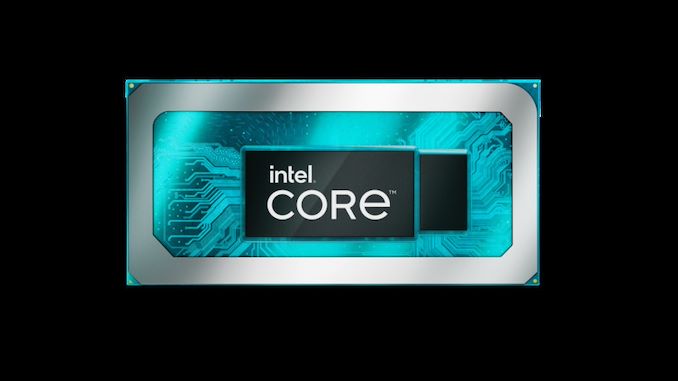
Not just focused on their new 13th gen Core desktop chips, Intel this morning is also kicking off 2023 for its mobile customers in a big way with the announcement of the 13th generation Core mobile family. Based on the same Raptor Lake architecture as Intel's 13th gen Core desktop chips, Intel is launching (or at least, announcing) the full 13th gen mobile stack all in one go. This means everything from the ultra-portable U-series chips up to the desktop replacement-class HX-series. All of them gaining Raptor Lake's CPU architectural enhancements, along with a smattering of new features that are coming to the overall platform.
Leading the lineup – and first SKUs out the door – are the 13th generation Core HX-series processors for high-performance notebooks. With SKUs featuring up to 24 CPU cores (8P+16E), Intel is looking to deliver desktop-level performance in the mobile space, with turbo clock speeds of up to 5.6 GHz, a turbo TDP of 157 W, and a base TDP of 55 W. Like previous iterations of the HX series, these parts are based on Intel's desktop silicon (Raptor Lake-S), so they are designed to be placed in DTR-class laptops and are almost always paired with a discrete GPU.
Also being announced today are the enthusiast-level H-series processors, Intel's more traditional mobile-optimized processors for high performance laptops. These offer fewer cores and slightly lower clockspeeds than the HX processors, but are better suited for mobile operation with a more powerful integrated GPU and support for technologies like LPDDR5 memory. Finally, joining the H-series will be Intel's thin and light performance-based P-series chips, and their U-series (ultra-thin) chips use in the most portable of laptops, making the usual power/performance tradeoffs to get Raptor Lake in increasingly light laptops.
As was the case with Intel's Raptor Lake desktop parts, their 13th gen Core mobile parts are largely a drop-in replacement for their previous-generation Alder Lake processors. This means that Intel's army of OEM partners are going to be hitting the ground running with laptops incorporating the new chips – and CES will be awash in new laptop announcements. All told, Intel has an extensive lineup of SKUs on offer, benefiting from its Intel 7 node and hybrid architecture of performance (P) and efficiency (E) cores. There's a whole stack of Raptor Lake mobile processors for every price point and requirement, from high-end gaming to portable workstation levels, as well as run-of-the-mill entry-level notebooks for users on a budget.
Finally, Intel has once again updated its Evo program for the latest generation of processors, partnering with several OEMs to certify a select class of notebooks that integrate the latest and greatest of Intel's mobile technology and best design practices.
Intel 13th Gen HX-Series Processors: Up to 24 CPU Cores, 5.6 GHz Max Turbo
The flagship line of Intel's new 13th Gen Core mobile processors are the nine new HX-series mobile parts. Intel hasn't only outlined its intent to equip OEMs with high-performance chips based on its desktop silicon, but they have just launched the first 24-core laptop-level processors, the Core i9-13980HX, the Core i9-13950HX, and the Core i9-13900HX to the market. Intel's Core i9-13980HX is also the fastest mobile processor with a turbo clock speed of 5.6 GHz, which for a notebook is impressive.
The key features of Intel's 13th Gen Core HX platform for mobile include up to 24 CPU cores, split up into 8 Performance and 16 Efficiency cores, which is the same core count as the flagship desktop Core i9-13900K. Also present is support for DDR5-5600 and DDR4-3200 memory (but no LPDDR5), along with up to 128 GB across four memory slots in a 2DPC configuration. One fascinating element of the HX-series is that it supports PCIe 5.0 x16, which can be split into 2x8, Intel doesn't state if this will be limited to just graphics or if notebook OEMs can integrate PCIe 5.0 x4 M.2 slots into the mix.
As this is based on Intel's desktop silicon and PCH, what you won't find here is integrated Thunderbolt 4 support. Instead, OEMs will need to add that via discrete TB4 controllers, and there's scope to include up to two such controllers here. Otherwise, the platform offers up to eight SATA ports, ten USB 3 ports, and up to fourteen USB 2 port (although no notebook OEM or design uses anywhere close to this). Intel includes dynamic overclocking support, XMP 3.0 memory profiling, and other Raptor Lake-S SKUs from the desktop side benefits from Intel Tread Director when used with the latest Windows 11 22H2 update.
| Intel 13th Gen Core HX-Series (Raptor Lake Mobile) | ||||||||||
| AnandTech | Cores P+E/T |
P-Core Base |
P-Core Turbo |
E-Core Base |
E-Core Turbo |
L3 Cache (MB) |
Processor Graphics | Base W |
Turbo W |
Intel vPro |
| i9-13980HX | 8+16/32 | 2200 | 5600 | 1600 | 4000 | 36 | 32 EU | 55 | 157 | - |
| i9-13950HX | 8+16/32 | 2200 | 5500 | 1600 | 4000 | 36 | 32 EU | 55 | 157 | Y |
| i9-13900HX | 8+16/32 | 2200 | 5400 | 1600 | 3900 | 36 | 32 EU | 55 | 157 | - |
| i7-13850HX | 8+12/28 | 2100 | 5300 | 1500 | 3800 | 30 | 32 EU | 55 | 157 | Y |
| i7-13700HX | 8+8/24 | 2100 | 5000 | 1500 | 3700 | 30 | 32 EU | 55 | 157 | - |
| i7-13650HX | 6+8/20 | 2600 | 4900 | 1900 | 3600 | 24 | 16 EU | 55 | 157 | - |
| i5-13600HX | 6+8/20 | 2600 | 4800 | 1900 | 3600 | 24 | 32 EU | 55 | 157 | Y |
| i5-13500HX | 6+8/20 | 2500 | 4700 | 1800 | 3500 | 24 | 16 EU | 55 | 157 | - |
| i5-13450HX | 6+4/16 | 2400 | 4600 | 1800 | 3400 | 20 | 16 EU | 55 | 157 | - |
Looking at the Intel 13th Gen Core HX-series stack, the top processor in the series is the Core i9-13980HX, which has 24-cores (8P+16E) with a P-core turbo of 5.6 GHz, and a P-core base frequency of 2.2 GHz under a turbo power rating of 157 W; the base TDP is 55 W. Compared to the flagship SKU, the Core i9-13950HX backs off on the max P core clockspeed ever so slightly, while it's also going to be offered to Intel's enterprise customers with vPro capabilities. The Core i9-13900HX goes just a bit further down yet, dropping frequencies to 5.4 GHz for the P-core turbo and 3.9 GHz for the E-core turbo clock speeds.
Moving down the HX-series SKUs are the Core i7 models with varying levels of core and thread counts, including the top model from the family is the Core i7-13850HX with 20-cores (8P+12E), with a P-core turbo of 5.3 GHz and a base frequency of 2.1 GHz. The Core i7-13700HX has 16 cores (8P+8E), a P-core turbo of 5 GHz, and a base frequency of 2.1 GHz. Both of these models include 30 MB of Intel L3 smart cache, although the Core i7-13650HX has just 14-cores (6P+8E).
Finally, perhaps the biggest surprise here is that Intel has expanded the i5 SKUs within the HX lineup to three chips (12th gen HX offered 2), indicating that Intel is going to be chasing a wider portion of the mid-range market with their HX chips. The Core i5 family of Raptor Lake HX-series models includes two 14-core SKUs (i5-13600HX and i5-13500HX) with similar clock speeds. However, the Core i5-13600HX benefits from Intel vPro support, making it viable for enterprise notebooks. The Core i5-13450HX has just 10 cores (6P+4E), a P-core turbo of 4.6 GHz, and a base frequency of 2.4 GHz.
Enabled to deliver power where it's needed, all of Intel's 13th Gen Core series processors, both on desktop and mobile, are designed to benefit from Intel Thread Director, which is a feature designed alongside Microsoft through its Windows 11 22H2 update to assign the correct core to the assigned processing task. Intel's 13th Gen Core HX-series chips all have a base TDP of 55 W and a turbo TDP of 157 W.
As with the previous (12th Gen) chips, the 13th Gen HX-series is primarily meant to be paired with a discrete GPU. All of these chips come with a basic integrated GPU based on Intel's Xe-LP architecture – the same as we saw on the desktop – with most SKUs getting 32EU configurations, while the lower-end i7 and i5s get just 16EUs. So HX-series laptops will need an additional GPU for graphics-heavy tasks, and you should expect to see them typically paired with NVIDIA GeForce (and if Intel has their way, Arc) GPUs.
Intel 13th Gen H-Series: More Traditional Mobile Silicon, Up to 14-Cores
The middle, yet also the staple of Intel's 13th Gen Core series processors for mobile, comes under the H-series banner. Intel has eleven new H-series SKUs, with the top Core i9 series benefiting from 14 cores and 20 threads (6P+8E).
Some of the main benefits of the H-series (as well as the P and U series) includes support for up to four Thunderbolt 4 connectors, four USB 3 and ten USB 2 ports, as well as two SATA ports, and varying levels of memory support, including up to DDR5-5200/LPDDR5-6400, or DDR4-3200. The default package for the H-series is Intel's Type 3 package, which incorporates the CPU and PCH on a single 50x25x1.3mm chip. A handful of consumer-focused SKUs are also available in Type 4 packaging, which shaves off some memory and TB4 I/O for a smaller 40x25x1.25mm package.
| Intel 13th Gen Core H-Series (Raptor Lake Mobile) | ||||||||||
| AnandTech | Cores P+E/T |
P-Core Base |
P-Core Turbo |
E-Core Base |
E-Core Turbo |
L3 Cache (MB) |
Processor Graphics | Base W |
Turbo W |
Intel vPro |
| i9-13900HK | 6+8/20 | 2600 | 5400 | 1900 | 4100 | 24 | 96 EU | 45 | 115 | Y* |
| i9-13950H | 6+8/20 | 2600 | 5400 | 1900 | 4100 | 24 | 96 EU | 45 | 115 | - |
| i9-13900H | 6+8/20 | 2600 | 5400 | 1900 | 4100 | 24 | 96 EU | 45 | 115 | Y |
| i7-13800H | 6+8/20 | 2500 | 5200 | 1800 | 4000 | 24 | 96 EU | 45 | 115 | Y |
| i7-13750H | 6+8/20 | 2400 | 5000 | 1800 | 3700 | 24 | 96 EU | 45 | 115 | - |
| i7-13700H | 6+8/20 | 2400 | 5000 | 1800 | 3700 | 24 | 96 EU | 45 | 115 | Y* |
| i7-13620H | 6+4/16 | 2400 | 4900 | 1800 | 3600 | 24 | 64 EU | 45 | 115 | - |
| i5-13600H | 4+8/16 | 2800 | 4800 | 2100 | 3600 | 18 | 80 EU | 45 | 95 | Y |
| i5-13505H | 4+8/16 | 2600 | 4700 | 1900 | 3500 | 18 | 80 EU | 45 | 95 | - |
| i5-13500H | 4+8/16 | 2600 | 4700 | 1900 | 3500 | 18 | 80 EU | 45 | 95 | Y* |
| i5-13420H | 4+4/12 | 2100 | 4600 | 1500 | 3400 | 12 | 48 EU | 45 | 95 | - |
* - Supports Intel vPro 'Essentials'
Looking at the H-series product stack, the top Core i9 models all share the same core and thread count (6P+8E/20), base and turbo clock speeds, and 24 MB of L3 (Smart) cache. The power configuration for all of the i9 SKUs is a base TDP of 45 W and a turbo TDP of 115 W.
The only consistent difference between the three SKUs is that, as the sole K SKU, Core i9-13900HK features unlocked CPU multipliers, allowing for CPU overclocking. This SKU also offers Intel's vPro Essentials. Meanwhile, the Core i9-13900H is designed for enterprise notebooks with full support for their vPro technologies. Finally, the Core i9-13950H supports neither vPro and is designed for consumer notebooks, and is the only i9 SKU available in the optional Type 4 package.
The Core i5 H-series family varies between 14-core models, with one 10-core model (Core i7-13620H) designed to offer mid-range performance levels but with a smaller overall cost than the HX-series. The Core i7-13800H is designed for the enterprise market with support for Intel vPro, while the Core i7-13700H has support for vPro Essentials. For the consumer market, the Core i7-13750H has a P-core turbo of 5 GHz and a base frequency of 2.4 GHz under a turbo TDP of 115 W, which is ample for delivering the power budget where and when it is needed.
At the bottom of the H-series line-up is the Core i5 series, with three SKUs benefiting from 12-core and 16-threads, with turbo clock speeds ranging from 4.8 to 4.7 GHz, and a base frequency of 2.8 GHz on the Core i5-13600H and 2.6 GHz on the Core i5-13505H and i5-13500H models. The entry-level H-series model is the Core i5-13420H with 8-cores and 12-threads (4P+4E), with just 12 MB of L3 cache, whereas the other i5 models benefit from 18 MB. The base TDP for all the Core i5 models sits at 45 W, while the turbo TDP is 95 W.
Finally, the bulk of the H-series chips will come with Intel's full-fledged 96EU Iris Xe Graphics, which is the same configuration as on the top-end H-series chips in the previous generation. This starts getting cut down with the i7-13620H, which offers just 64 EUs, and then the i5 range is 80 EUs, except for the entry-level i5-13420H at 40 EUs. H-series laptops can also be paired with discrete graphics, and as we saw with the previous generation, will typically appear as a premium/high-performance option for the larger notebooks.
Intel 13th Gen P & U-Series SKUs: For Thin and Light Notebooks
The remaining stack of Intel's 13th Gen Core processors hails from its P and U-series. To summarize both ranges, the 13th Gen P-series SKUs represent its performance but are designed for a thin and light chassis, signified with a 28 W base TDP and a turbo TDP of 64 W across these models. The P-series models are more geared towards enterprise users, with each chip benefiting from full Intel vPro support or vPro essentials technologies.
The P-series stack is notably smaller this time around. Whereas the 12th Gen offered 6 SKUs among the i3, i5, and i7 families, Intel has reduced that to just 4 SKUs spread over the i7 and i5 families for this generation.
| Intel 13th Gen Core P/U-Series (Raptor Lake Mobile) | ||||||||||
| AnandTech | Cores P+E/T |
P-Core Base |
P-Core Turbo |
E-Core Base |
E-Core Turbo |
L3 Cache (MB) |
Processor Graphics | Base W |
Turbo W |
Intel vPro |
| i7-1370P | 6+8/20 | 1900 | 5200 | 1400 | 3900 | 24 | 96 EU | 28 | 64 | Y |
| i7-1360P | 4+8/16 | 2200 | 5000 | 1600 | 3700 | 18 | 96 EU | 28 | 64 | Y* |
| i7-1365U | 2+8/12 | 1800 | 5200 | 1300 | 3900 | 12 | 96 EU | 15 | 55 | Y |
| i7-1355U | 2+8/12 | 1700 | 5000 | 1200 | 3700 | 12 | 96 EU | 15 | 55 | Y* |
| i5-1350P | 4+8/16 | 1900 | 4700 | 1400 | 3500 | 12 | 80 EU | 28 | 64 | Y |
| i5-1340P | 4+8/16 | 1900 | 4600 | 1400 | 3400 | 12 | 80 EU | 28 | 64 | Y* |
| i5-1345U | 2+8/12 | 1600 | 4700 | 1200 | 3500 | 12 | 80 EU | 15 | 55 | Y |
| i5-1335U | 2+8/12 | 1300 | 4600 | 900 | 3400 | 12 | 80 EU | 15 | 55 | Y* |
| i5-1334U | 2+8/12 | 1300 | 4600 | 900 | 3400 | 12 | 80 EU | 15 | 55 | Y* |
| i3-1315U | 2+4/8 | 1200 | 4500 | 900 | 3300 | 10 | 64 EU | 15 | 55 | - |
| i3-1305U | 1+4/6 | 1600 | 4500 | 1200 | 3300 | 10 | 64 EU | 15 | 55 | - |
| IP-U300 | 1+4/6 | 1200 | 4400 | 900 | 3300 | 8 | 48 EU | 15 | 55 | - |
Meanwhile the U-series SKU list has also been trimmed for this generation. Intel has done away entirely with the formal 9 Watt TDP parts; now every 13th Gen Core U-series SKU is rated for a base TDP of 15 Watts. The previous 9W SKUs were in essence a compromise to offer something akin to Intel's older ultra-mobile Y-series/UP4 chips, which operated in the 7 to 9 Watt range. I expect OEMs still have some room to play here with configurable TDPs, but for the moment it looks like Intel has brought out the shovel for their sub-10W Core chips – at least where Performance cores are involved.
In any case, the Intel 13th Gen U-series processors are the lowest-power chips, designed for smallest and lightest notebooks. SKUs are available for the Core i7, i5, and i3 families, with a base TDP of 15 W and a turbo TDP of 55 W for all SKUs. Lighter on cores than the H and P-series SKUs, the U-series ranges from 10-core (2P+8E) models down to a 5-core (1P+4E) model, the Core i3-1305U. The Core i7 and Core i5 U-series processors come with full vPro, or vPro essentials support, while the Core i3 U-series models do not.
For iGPU configurations, the P and U-series are very straightforward, a refreshing reprieve from the H-series. All of the i7 parts come with a full 96 EU Iris Xe Graphics configuration, while all of the i5s come with 80 EUs, and finally the i3s come with 64 EUs.
Last and a bit least, Intel is offering a single SKU that is a sub-i3 part, which they are calling the Intel Processor U300. This is a cut-down version of the i3-1305U, offering the same 1P+4E CPU core configuration, but at even lower frequencies. The integrated GPU also takes a hit, dropping to just 48 EUs. In light of Intel retiring the Celeron and Pentium brands for laptops last year, this is essentially the 13th Gen Core equivalent of the Core-based Pentium. Its even more limited Celeron counterpart is nowhere to be found for this generation, making this the bottom of Intel's Raptor Lake-based mobile product stack.
As part of Intel's EVO notebook certification, a swathe of OEMs and vendors will likely release a series of notebooks during CES 2023 in Las Vegas, US, which begins on January 5th and ends on Sunday, the 8th of January. We expect a wide variety of new models to be announced from Intel's partners, such as Dell, HP, and Lenovo, over the coming weeks featuring Intel's latest 13th Gen mobile series processors.
Whether that is top-tier gaming notebooks from Dell/Alienware, Razer, ASUS, MSI, and GIGABYTE with the 13th Gen Core HX-series or high-end slimline offerings with H and P-series models, there will be something for every user requirement in the mobile workspace, including the U-series models expected to feature in entry-level models. However, we haven't been given a specific pricing range for any of Intel's newly announced ranges. Expect this to be around the previous 12th Core Gen pricing as new models hit retail shelves this month.


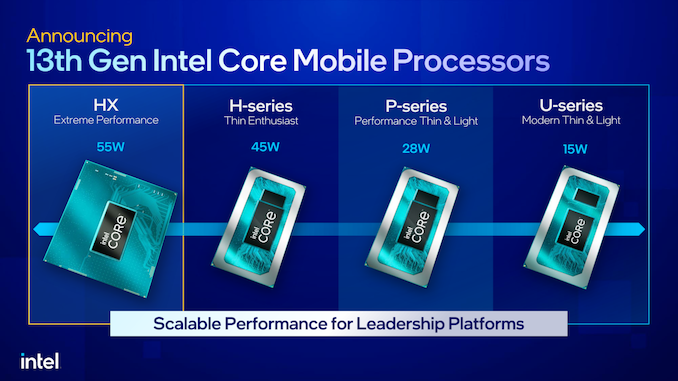
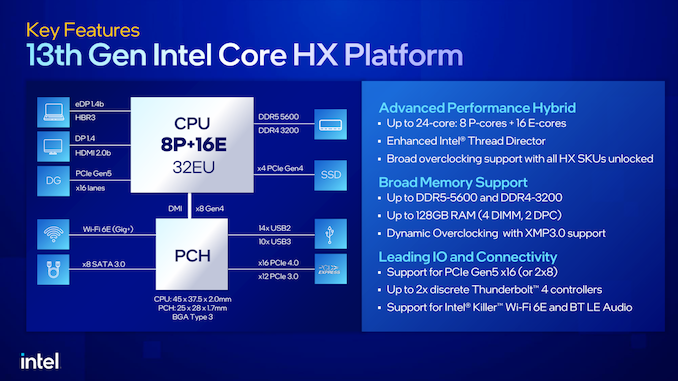
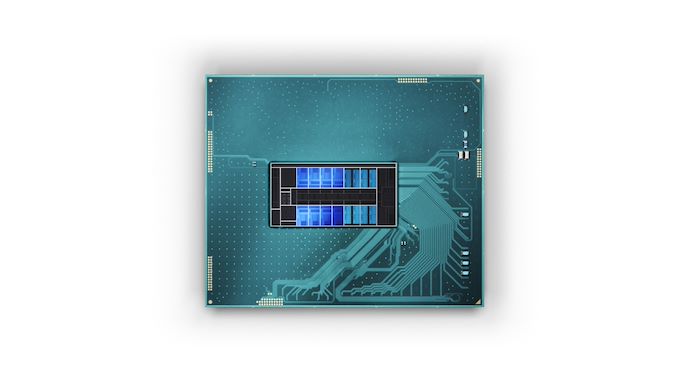
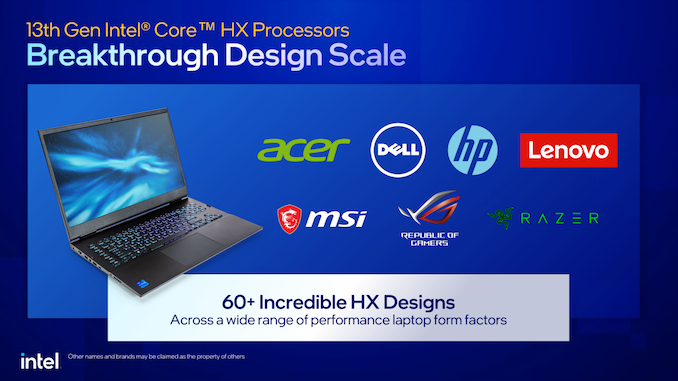
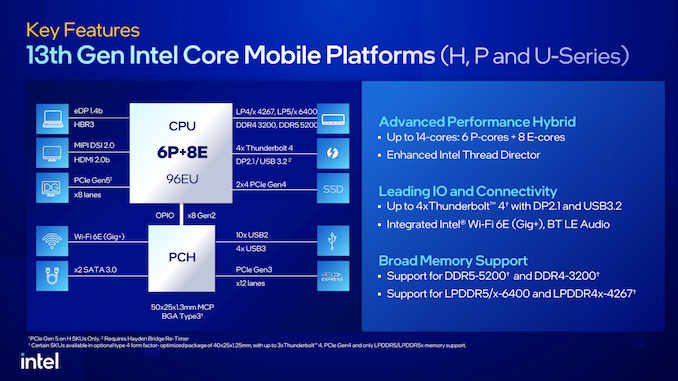
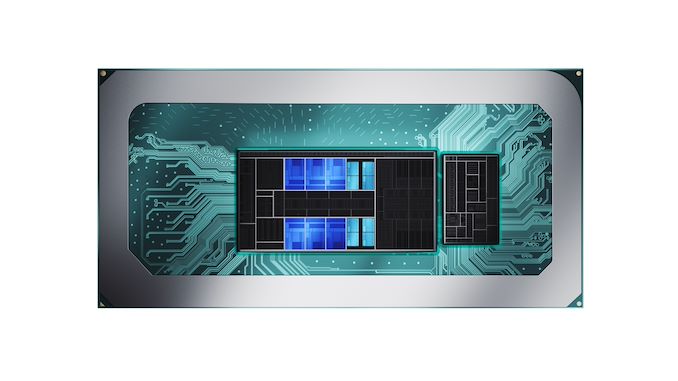
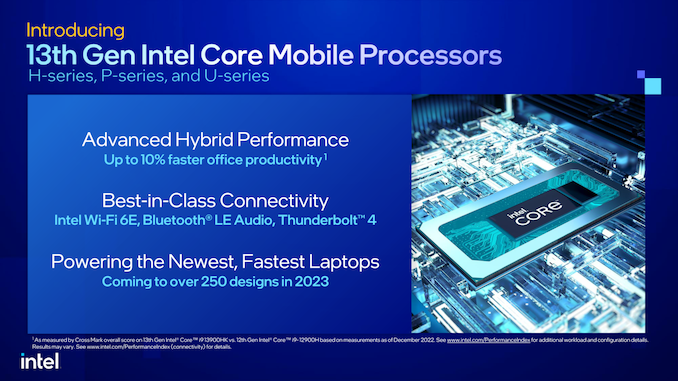


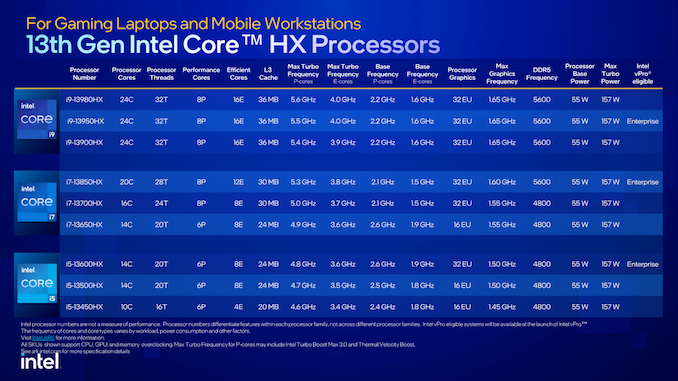

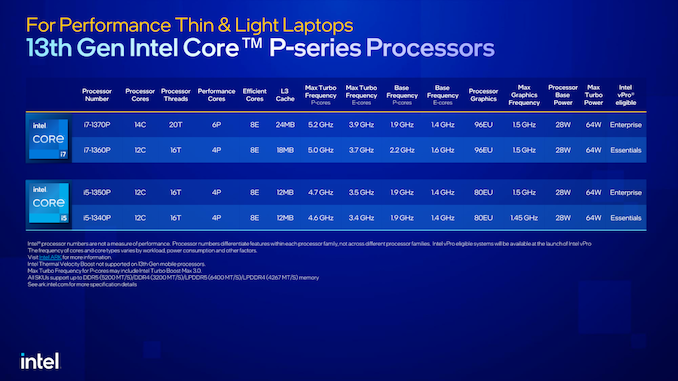















38 Comments
View All Comments
meacupla - Tuesday, January 3, 2023 - link
Intel being Intel, and having way too many SKUs.And why is there 5 digits on the HX and H, where as the P and U only have 4 digits?
dontlistentome - Tuesday, January 3, 2023 - link
.. because the HX and H use as much power as the desktop parts ... might as well call them the same.meacupla - Tuesday, January 3, 2023 - link
Do they really though? Desktop 13th gen i9 pulls 125W base with >250W boostdontlistentome - Wednesday, January 4, 2023 - link
Was being (a little) sarcastic. Those H chips can pull a scary amount of power - PL1 is 125w iirc.Yojimbo - Tuesday, January 3, 2023 - link
Too many SKUs for whom, exactly?meacupla - Tuesday, January 3, 2023 - link
for the consumer who does not have intricate knowledge of how the CPU performs?Samus - Tuesday, January 3, 2023 - link
It doesn't matter how many SKU's. OEM's will focus on a few for the mainstream, much like they have for decades going back to the 486. I suspect the 1340P will be the most popular mobile chip, much like the 1240P was. The U series really makes no sense at this point to OEM's when considering cost and implementation: the P series is cheaper and can be tuned to run as cool as a U series by capping its turbo.hemedans - Tuesday, January 3, 2023 - link
There are Celeron and Pentium replacement in those U, with 1 big core and 4 small cores.Samus - Tuesday, January 3, 2023 - link
I suspect the recently launched N series is going to make the 1P\4E Pentium and Celeron's irrelevant unless, again, price is a significant factor.Kangal - Friday, January 6, 2023 - link
I'd want to a see a direct comparison of the 13th-gen Mobile Raptor Lake versus 12th gen Mobile Alder Lake.(1+4) Intel U300 vs Pentium 8505
(2+8) i7-1365U vs i7-1265U
(4+8) i7-1350p vs i7-1270p
(6+8) i7-1370p vs i7-1280p